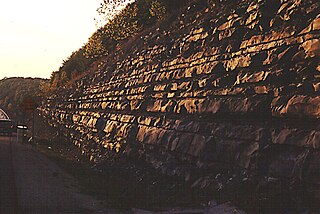 W
WThe Bakken Formation is a rock unit from the Late Devonian to Early Mississippian age occupying about 200,000 square miles (520,000 km2) of the subsurface of the Williston Basin, underlying parts of Montana, North Dakota, Saskatchewan and Manitoba. The formation was initially described by geologist J.W. Nordquist in 1953. The formation is entirely in the subsurface, and has no surface outcrop. It is named after Henry Bakken, a farmer in Tioga, North Dakota, who owned the land where the formation was initially discovered while drilling for oil.
 W
WThe Barnett Shale is a geological formation located in the Bend Arch-Fort Worth Basin. It consists of sedimentary rocks dating from the Mississippian period in Texas. The formation underlies the city of Fort Worth and underlies 5,000 mi² (13,000 km²) and at least 17 counties.
 W
WThe Bear Gulch Limestone in Montana is a fossiliferous lagerstätte, a limestone layer laid down in the Bashkirian Stage of the early Pennsylvanian epoch of the Carboniferous period, about 318 mya.
 W
WThe Mississippian Borden Formation is a mapped bedrock unit in Kentucky, Indiana, Illinois, Ohio, West Virginia, and Tennessee. It has many members, which has led some geologists to consider it a group rather than a formation.
 W
WThe Mississippian Pocono Formation is a mapped bedrock unit in Pennsylvania, Maryland, and West Virginia, in the United States. It is also known as the Pocono Group in Maryland and West Virginia, and the upper part of the Pocono Formation is sometimes called the Burgoon Formation or Burgoon Sandstone in Pennsylvania. The Pocono is a major ridge-former In the Ridge-and-Valley Appalachians of the eastern United States
 W
WThe Cuyahoga Formation is a geologic formation in Ohio. The age of the formation is difficult to determine, because of a lack of diagnostic fossils. Roughly, the formation dates from the Late Kinderhookian to the Middle Osagean. Eight members are recognized, among them the Orangeville Shale, Sharpsville Sandstone, and Meadville Shale.
 W
WThe Fayetteville Shale is a geologic formation of Mississippian age composed of tight shale within the Arkoma Basin of Arkansas and Oklahoma. It is named for the city of Fayetteville, Arkansas, and requires hydraulic fracturing to release the natural gas contained within.
 W
WThe Greenbrier Limestone, also known locally as the "Big Lime", is an extensive limestone unit deposited during the Middle Mississippian Epoch, part of the Carboniferous Period. This rock stratum is present below ground in much of West Virginia and neighboring Kentucky, and extends somewhat into adjacent western Maryland and southwestern Virginia. The name derives from the Greenbrier River in West Virginia.
 W
WThe Madison Limestone is a thick sequence of mostly carbonate rocks of Mississippian age in the Rocky Mountain and Great Plains areas of western United States. The rocks serve as an important aquifer as well as an oil reservoir in places. The Madison and its equivalent strata extend from the Black Hills of western South Dakota to western Montana and eastern Idaho, and from the Canada–United States border to western Colorado and the Grand Canyon of Arizona.
 W
WThe Mississippian Pocono Formation is a mapped bedrock unit in Pennsylvania, Maryland, and West Virginia, in the United States. It is also known as the Pocono Group in Maryland and West Virginia, and the upper part of the Pocono Formation is sometimes called the Burgoon Formation or Burgoon Sandstone in Pennsylvania. The Pocono is a major ridge-former In the Ridge-and-Valley Appalachians of the eastern United States
 W
WThe Late Mississippian-Early Pennsylvanian Surprise Canyon Formation is a conglomerate, sandstone, limestone and dark purple siltstone type formation, occurring as 'channel fill'. The Surprise Canyon Formation was deposited upon a mostly horizontal, much eroded Redwall Limestone surface, the Redwall originally deposited as marine-(oceanic) limestone, ; when the Surprise Canyon Formation was being deposited, the Redwall Limestone surface existed under karst topography conditions, in a "warm, and humid" (paleo)-environment. The karst topography created "sinks, caves, and underground channels", and created "deep ravines and stream valleys developed as caverns collapsed". Some valleys probably filled with " 'clayey red-orange soil' similar to that known in the Tropics today." Below the Redwall surface, solution-cavern deposits of the Surprise Canyon, have a Redwall Limestone geologic layer, now expressed above them.